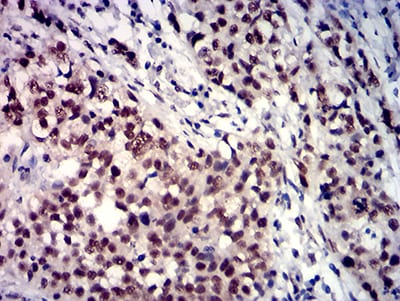





| WB | 1/500 - 1/2000 | Human,Mouse,Rat |
| IF | 咨询技术 | Human,Mouse,Rat |
| IHC | 1/200 - 1/1000 | Human,Mouse,Rat |
| ICC | 1/200 - 1/1000 | Human,Mouse,Rat |
| FCM | 1/200 - 1/400 | Human,Mouse,Rat |
| Elisa | 1/10000 | Human,Mouse,Rat |
| Aliases | HDL4; GTF2D; SCA17; TFIID; GTF2D1 |
| Entrez GeneID | 6908 |
| clone | 7G11C8 |
| WB Predicted band size | 37.7kDa |
| Host/Isotype | Mouse IgG1 |
| Antibody Type | Primary antibody |
| Storage | Store at 4°C short term. Aliquot and store at -20°C long term. Avoid freeze/thaw cycles. |
| Species Reactivity | Human |
| Immunogen | Purified recombinant fragment of human TBP (AA: 1-144) expressed in E. Coli. |
| Formulation | Purified antibody in PBS with 0.05% sodium azide |
+ +
以下是关于TBP抗体的3篇参考文献,涵盖其应用验证、特异性分析及疾病研究:
1. **文献名称**:*"Comprehensive validation of TBP-specific antibodies for chromatin immunoprecipitation assays"*
**作者**:Miller CL, et al.
**摘要**:研究系统评估了多种TBP抗体在ChIP实验中的效能,证实了部分抗体可特异性富集人类细胞中与启动子区域结合的TBP蛋白,为转录调控研究提供可靠工具。
2. **文献名称**:*"Comparative evaluation of TBP antibodies in neurodegenerative disease models"*
**作者**:Garcia-Ruiz S, et al.
**摘要**:通过免疫组化和Western blot分析,比较了TBP抗体在小鼠亨廷顿病模型中的检测性能,发现特定抗体可灵敏追踪脑组织中TBP的异常聚集。
3. **文献名称**:*"TBP antibody cross-reactivity in non-mammalian species: Implications for evolutionary studies"*
**作者**:Tanaka H, et al.
**摘要**:探讨了TBP抗体在斑马鱼和果蝇中的交叉反应性,揭示了部分抗体适用于跨物种比较研究,为进化保守的转录机制分析提供支持。
每篇文献均围绕TBP抗体的实际应用场景,强调其在实验中的验证与优化,满足不同研究需求。
**Background of TBP Antibodies**
TATA-box binding protein (TBP) is a critical transcription initiation factor that binds to the TATA-box DNA sequence in gene promoters, playing a central role in RNA polymerase II-mediated transcription. As a core component of the TFIID complex, TBP facilitates the assembly of the pre-initiation complex, enabling precise regulation of gene expression across eukaryotes. Its conserved structure, characterized by a saddle-shaped domain for DNA interaction, underscores its essential function in basal transcription.
TBP antibodies are immunological tools designed to detect, quantify, or isolate TBP in research and diagnostic applications. These antibodies, often monoclonal or polyclonal, are validated for techniques like Western blotting, chromatin immunoprecipitation (ChIP), immunofluorescence (IF), and electrophoretic mobility shift assays (EMSAs). They help investigate TBP’s expression dynamics, interactions with transcriptional machinery, and alterations in diseases such as neurodegenerative disorders and cancers, where dysregulated transcription is implicated.
The development of TBP-specific antibodies has advanced studies on transcriptional regulation, cellular differentiation, and disease mechanisms. However, challenges remain in ensuring specificity, as TBP shares homology with related proteins (e.g., TBPL1/2). Rigorous validation and controls are thus essential for reliable data. Overall, TBP antibodies remain indispensable for dissecting the molecular underpinnings of gene expression and its pathologies.
×